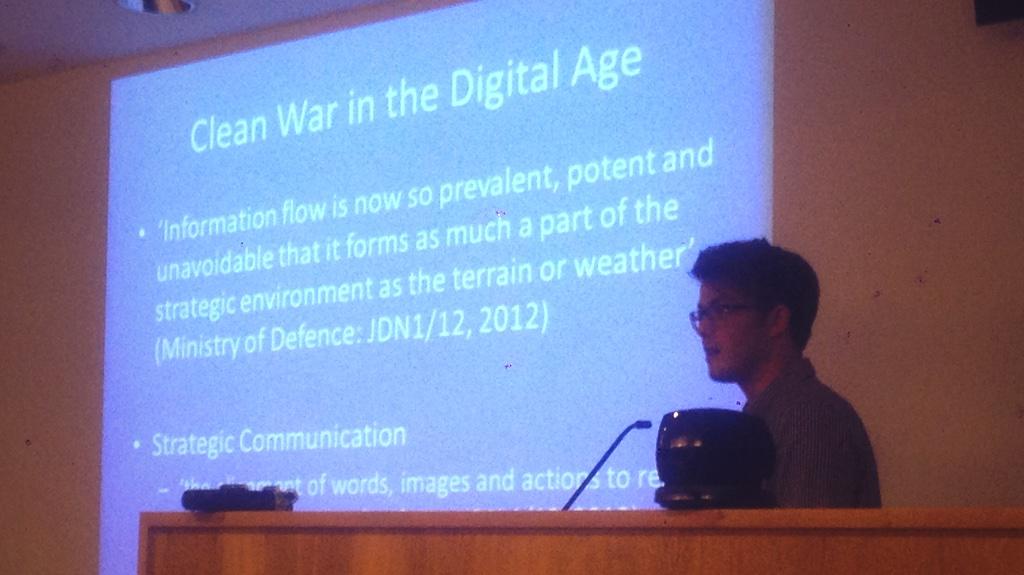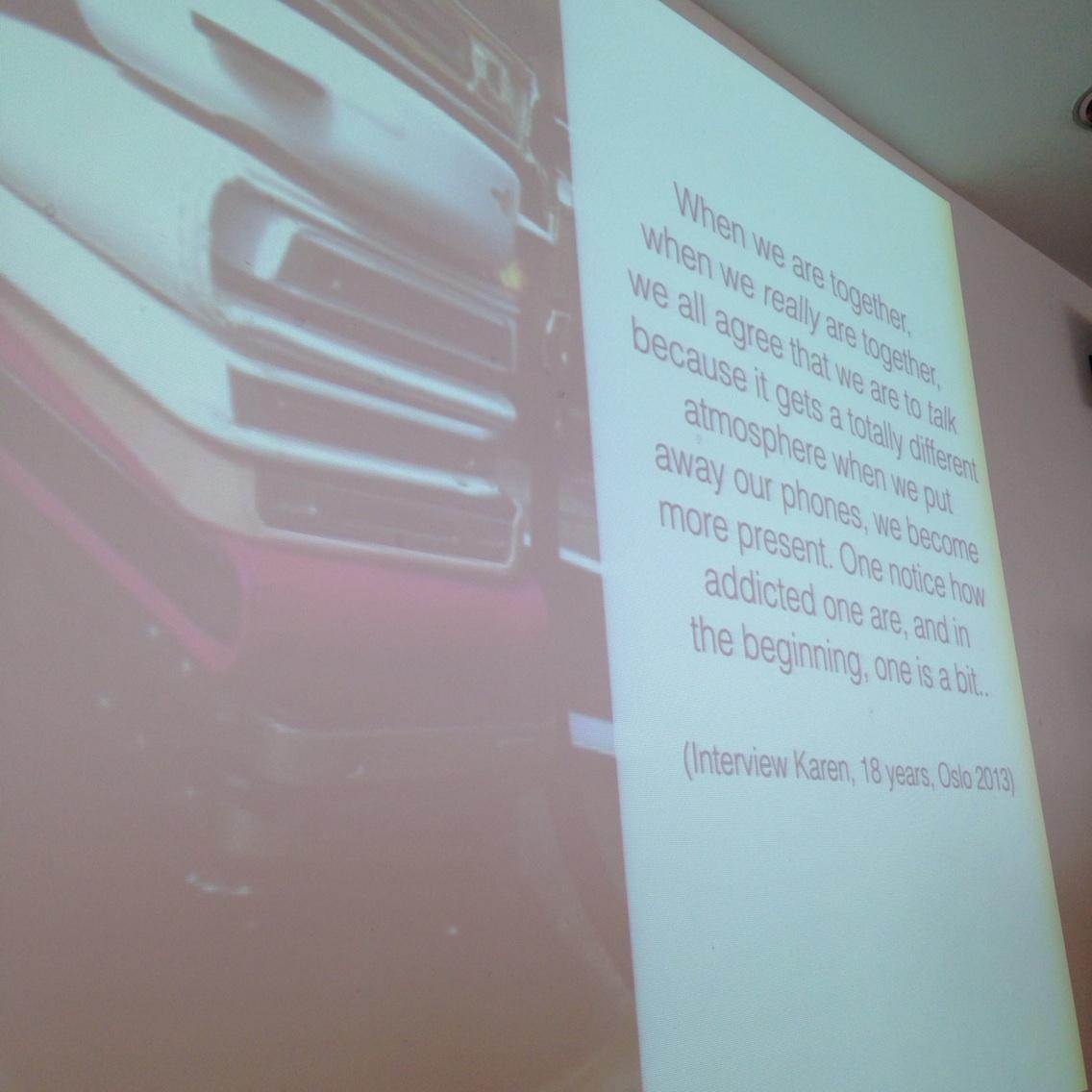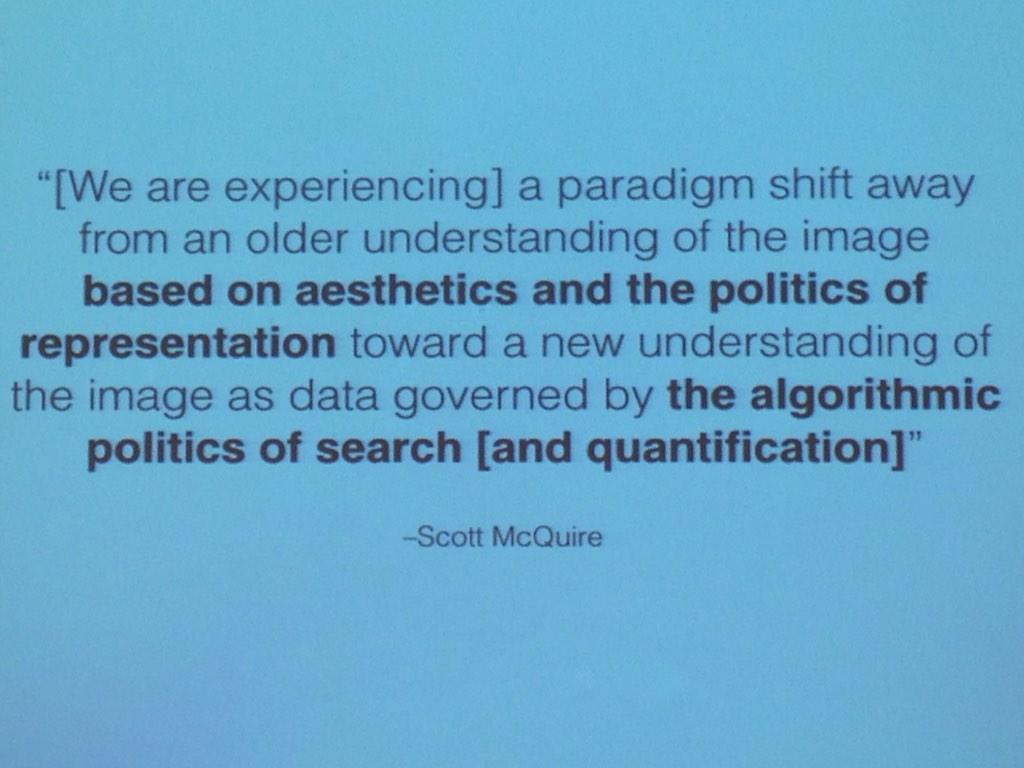The headline for each thought is below - then underneath the summary of the 12 there is a bit more detail on each one.
1) We share 750 million + social media images daily - an agenda of visual (digital) studies
2) Visual data mining is where text mining was late 90s - "Facefmetadata" is a thing
3) Social media data (esp Twitter) decays in several ways - missing links on social media
4) Use of the word "selfie" increased by 17000% last year - generations take pics differently
5) Comments on women's selfies = social control - repressive ideas naturalised as leisure
6) Military selfies expose & obscure on conflicts - & incorporate into the everyday.
7) We now have visual render ghosts on social media - pics of people in digital visualisations
5) Comments on women's selfies = social control - repressive ideas naturalised as leisure
6) Military selfies expose & obscure on conflicts - & incorporate into the everyday.
7) We now have visual render ghosts on social media - pics of people in digital visualisations
8) Images are now data governed by algorithmic politics - and quantification
9) Is Polaroid an app because analogue = authentic? - and digital is viewed with suspicion
10) #Slacktavism - Thinly veiling vanity as philanthropy - narcissistic or true heroes
11) Military use social media to portray war as clean - hygienic and bloodless
12) Camera phones & social media mediate other media - using the Thatcher death eg
1) We share 750 million + social media images daily
Paper by Dr Farida Vis @flygirltwo (Faculty Research Fellow at the University of Sheffield) on Picturing the Social: Analysing Social Media Images
2) Visual data mining is where text mining was late 90s
Images are playing more than ever a crucial role in our lives and shaping our culture. However, there is still a very limited understanding of the visual dynamics of social media and the social media research approaches and toolbox are still focused on textual rather than visual content.
The classic triad that has been the foundation of the visual culture approach (representation, meaning, culture) cannot be easily supported within a quantitative data-mining framework. If ethics comes into question when analyzing user generated textual content, concerns should be even higher when analyzing images, which are far more revealing than text.
Paper by Dr Francesco D’Orazio (Vice President of Product at social analytics firm Pulsar and Chief Innovation Officer at research consultancy FACE) on From Tristan and Isolde to Visual Social Media: the pains, pleasures and myths of researching images in social media
3) Social media data (esp Twitter) decays in several ways
Paper by Shawn Walker (PhD Candidate,University of Washington Information School) on The Missing Link: Link and Image Decay in Social Media
4) Use of the word "selfie" increased by 17000% last year
Technologies of the self and self-documenting are one increasing phenomenon and practice saturating our everyday lives. On Instagram there are 130 billion mobile self-portraits that are hashtagged selfie.
There is a need to question what this phenomenon is a result of and what significance it has on how we socialize; how we understand the culture we are a part of; and how we understand ourselves.
Paper by Dr. Lin Prøitz (Guest Researcher at Centre for Gender Research, University of Oslo) on From Self-presentation to #Selfie. Identity and the self in a visual digital culture
5) Comments on women's selfies = social control
Discourse regarding women’s photographic self-representation on the web acts as a form of social control, in which perpetuating repressive ideas has become naturalised as a contemporary form of leisure.
Ideas of what should and shouldn’t be shared, whose images are more legitimate than others’, and what genres of images are more ‘worthwhile’ than others, serve to perpetuate gender inequality and legitimise the criticising of subjects, through their photographic practice. The discussion around photography is therefore to be regarded as technique of subjugation, in which shame and humiliation are enacted in order to maintain unequal power relations.
Paper by Anne Burns (PhD candidate at Loughborough University) on Self(ie)-Control: Narratives of Photographic Restraint and the Regulation of Social Conduct
6) Military selfies expose & obscure on conflicts
The talk was part of her forthcoming co-authored book, Digital Militarism (with Rebecca L. Stein, Stanford UP, 2015), which focuses on the evolution of Israeli digital militarism, and in particular, on the emergence of “selfie militarism”.
Paper by Dr Adi Kuntsman (Lecturer in Digital Media, Manchester Metropolitan University) on Selfie Militarism
7) We now have visual render ghosts on social media
Digital photography is being used in a huge number of ways now. The technology is so pervasive that it is necessary to develop a more elaborate vocabulary to understand its working and effects, and a less evaluative stance towards it.
On the subject of render ghosts (photographs of people that have been inserted into digital visualisations of new urban developments via PhotoShop) read more here and here
Digital photography is best understood as a range of particular combinations of social practice (including ways of seeing), software and hardware. These come together not only in everyday spaces like streets, schools and teenage bedroom, but also in places like app developers’ offices and server farms. I’ll suggest that we need a more distributed approach to the role of images in/on/as social media, which should explore a range of these sites and consider the relations between them.
Paper by Gillian Rose (Professor of Cultural Geography, The Open University) on Navigating digital photography
8) Images are now data governed by algorithmic politics
Today, the cultural dynamics of the database-driven web and real time image sharing are defining the new conditions of photographic production and circulation. The visibility, value and meaning of images are connected not only to social practices but software systems employed to sort, (mis) read and distribute image content.
Paper by Katrina Sluis (London South Bank University & The Photographers’ Gallery) on
All that happens must be known: mining the ocular white noise of the image stream
9) Is Polaroid an app because analogue = authentic?
Even before Polaroid shut its instant film factories in 2008, this obsolete photographic form was making a concerted return in a digitally simulated form, in a whole array of apps, ads, and merchandise.
The digital simulation of Polaroid images is just part of the wider phenomenon of filter programmes for camera phones, taking in Hipstamatic, Instagram, etc. This phenomenon is often taken to be driven by nostalgia, but given that so many of the users did not experience analogue Polaroids in the first place, nostalgia is not an entirely satisfactory explanation. What else is at stake in analogue afterlives?
Paper by Peter Buse (Professor, Head Of School Performance And Screen Studies, Kingston University) on Analogue afterlives
10) #Slacktavism - Thinly veiling vanity as philanthropy
The debate on hastag campaigns like #nomakeupselfie and #thumbsupforstephen campaign typically raises the following types of views:
- arguments taking the fashionable dismissive line that social media is riddled with the banal and the narcissistic, or for stripping human interaction of warmth as conversations shift away from the "real world" to the online sphere;
- or - in the #thumbsupforstephen campaign - a depiction of his last few weeks and the importance of him achieving his fundraising goal echoeing the classic ‘hero’s journey’ narrative of overcoming adversity to achieve one’s aims.
Paper by Ruth Deller (Principal Lecturer, Department of Media Arts and Communication, Sheffield Hallam University) on Charitable selfies, national identity and gender: comparing the #nomakeupselfie and #thumbsupforstephen campaigns
11) Military use social media to portray war as clean
There has been a growing body of research that has explored how ‘western’ warfare is increasingly represented as clean, hygienic and bloodless.

The paper seeks to analyse ‘clean war’ – conceptualised as a visuality that is used to claim legitimacy for violence – is producedand circulated on military social media sites.
Paper by Rhys Crilley (PhD candidate at The University of Birmingham) on Like and Share Forces: The British Army, Images and Clean War on Facebook
12) Camera phones & social media mediate other media
In particular the presentation considered images within the larger ‘Thatcher Death Tweets’ corpus that relate to the 1984-85 Miner’s Strike during the Thatcher premiership as well as those around her death
Paper by Simon Faulkner (Senior Lecturer, Department of Art, Manchester Metropolitan University) on Some Initial Thoughts on the ‘Thatcher Death Tweets’
9) Is Polaroid an app because analogue = authentic? - and digital is viewed with suspicion
10) #Slacktavism - Thinly veiling vanity as philanthropy - narcissistic or true heroes
11) Military use social media to portray war as clean - hygienic and bloodless
12) Camera phones & social media mediate other media - using the Thatcher death eg
1) We share 750 million + social media images daily
Towards an agenda of visual (digital) studies by @Flygirltwo #VisSocMedConf
Paper by Dr Farida Vis @flygirltwo (Faculty Research Fellow at the University of Sheffield) on Picturing the Social: Analysing Social Media Images
2) Visual data mining is where text mining was late 90s
Images are playing more than ever a crucial role in our lives and shaping our culture. However, there is still a very limited understanding of the visual dynamics of social media and the social media research approaches and toolbox are still focused on textual rather than visual content.
"Face metadata" is a thing (and this ReKognition API thinks Jennifer Aniston is 28) #VisSocMedConf
The classic triad that has been the foundation of the visual culture approach (representation, meaning, culture) cannot be easily supported within a quantitative data-mining framework. If ethics comes into question when analyzing user generated textual content, concerns should be even higher when analyzing images, which are far more revealing than text.
Paper by Dr Francesco D’Orazio (Vice President of Product at social analytics firm Pulsar and Chief Innovation Officer at research consultancy FACE) on From Tristan and Isolde to Visual Social Media: the pains, pleasures and myths of researching images in social media
3) Social media data (esp Twitter) decays in several ways
great talk by @walkeroh on missing links on social media #VisSocMedConf
Paper by Shawn Walker (PhD Candidate,University of Washington Information School) on The Missing Link: Link and Image Decay in Social Media
4) Use of the word "selfie" increased by 17000% last year
Technologies of the self and self-documenting are one increasing phenomenon and practice saturating our everyday lives. On Instagram there are 130 billion mobile self-portraits that are hashtagged selfie.
There is a need to question what this phenomenon is a result of and what significance it has on how we socialize; how we understand the culture we are a part of; and how we understand ourselves.
Really lovely insight from @linpro's ethnographic work on young people's use of social media. #VisSocMedConf
Paper by Dr. Lin Prøitz (Guest Researcher at Centre for Gender Research, University of Oslo) on From Self-presentation to #Selfie. Identity and the self in a visual digital culture
5) Comments on women's selfies = social control
Discourse regarding women’s photographic self-representation on the web acts as a form of social control, in which perpetuating repressive ideas has become naturalised as a contemporary form of leisure.
Some astonishing quotes from Anne Burns on "selfie-shaming" #VisSocMedConf
Ideas of what should and shouldn’t be shared, whose images are more legitimate than others’, and what genres of images are more ‘worthwhile’ than others, serve to perpetuate gender inequality and legitimise the criticising of subjects, through their photographic practice. The discussion around photography is therefore to be regarded as technique of subjugation, in which shame and humiliation are enacted in order to maintain unequal power relations.
@AnneLBurns on how duck face selfies encourage disdain and moral judgements on women's behaviour #VisSocMedConf
Paper by Anne Burns (PhD candidate at Loughborough University) on Self(ie)-Control: Narratives of Photographic Restraint and the Regulation of Social Conduct
6) Military selfies expose & obscure on conflicts
The talk was part of her forthcoming co-authored book, Digital Militarism (with Rebecca L. Stein, Stanford UP, 2015), which focuses on the evolution of Israeli digital militarism, and in particular, on the emergence of “selfie militarism”.
Adi Kuntsman talking about Eden Abergil images where she poses with Palestinian prisoners. #VisSocMedConf
Today, as soldiers carry smartphones alongside their weaponry the military selfies at once increasingly exposes and increasingly obscures, and are incorporated into the very fabric of the normal, the intimate, and the everyday.7) We now have visual render ghosts on social media
Digital photography is being used in a huge number of ways now. The technology is so pervasive that it is necessary to develop a more elaborate vocabulary to understand its working and effects, and a less evaluative stance towards it.
On the subject of render ghosts (photographs of people that have been inserted into digital visualisations of new urban developments via PhotoShop) read more here and here
Digital photography is best understood as a range of particular combinations of social practice (including ways of seeing), software and hardware. These come together not only in everyday spaces like streets, schools and teenage bedroom, but also in places like app developers’ offices and server farms. I’ll suggest that we need a more distributed approach to the role of images in/on/as social media, which should explore a range of these sites and consider the relations between them.
Paper by Gillian Rose (Professor of Cultural Geography, The Open University) on Navigating digital photography
8) Images are now data governed by algorithmic politics
Today, the cultural dynamics of the database-driven web and real time image sharing are defining the new conditions of photographic production and circulation. The visibility, value and meaning of images are connected not only to social practices but software systems employed to sort, (mis) read and distribute image content.
Great quote used by @k_treen (completely agreed) #VisSocMedConf
Paper by Katrina Sluis (London South Bank University & The Photographers’ Gallery) on
All that happens must be known: mining the ocular white noise of the image stream
9) Is Polaroid an app because analogue = authentic?
Even before Polaroid shut its instant film factories in 2008, this obsolete photographic form was making a concerted return in a digitally simulated form, in a whole array of apps, ads, and merchandise.
The digital simulation of Polaroid images is just part of the wider phenomenon of filter programmes for camera phones, taking in Hipstamatic, Instagram, etc. This phenomenon is often taken to be driven by nostalgia, but given that so many of the users did not experience analogue Polaroids in the first place, nostalgia is not an entirely satisfactory explanation. What else is at stake in analogue afterlives?
Paper by Peter Buse (Professor, Head Of School Performance And Screen Studies, Kingston University) on Analogue afterlives
10) #Slacktavism - Thinly veiling vanity as philanthropy
The debate on hastag campaigns like #nomakeupselfie and #thumbsupforstephen campaign typically raises the following types of views:
- arguments taking the fashionable dismissive line that social media is riddled with the banal and the narcissistic, or for stripping human interaction of warmth as conversations shift away from the "real world" to the online sphere;
- or - in the #thumbsupforstephen campaign - a depiction of his last few weeks and the importance of him achieving his fundraising goal echoeing the classic ‘hero’s journey’ narrative of overcoming adversity to achieve one’s aims.
Paper by Ruth Deller (Principal Lecturer, Department of Media Arts and Communication, Sheffield Hallam University) on Charitable selfies, national identity and gender: comparing the #nomakeupselfie and #thumbsupforstephen campaigns
11) Military use social media to portray war as clean
There has been a growing body of research that has explored how ‘western’ warfare is increasingly represented as clean, hygienic and bloodless.
'Clean war' in the digital age: @rhyscrilley at #VisSocMedConf

The paper seeks to analyse ‘clean war’ – conceptualised as a visuality that is used to claim legitimacy for violence – is producedand circulated on military social media sites.
Paper by Rhys Crilley (PhD candidate at The University of Birmingham) on Like and Share Forces: The British Army, Images and Clean War on Facebook
12) Camera phones & social media mediate other media
In particular the presentation considered images within the larger ‘Thatcher Death Tweets’ corpus that relate to the 1984-85 Miner’s Strike during the Thatcher premiership as well as those around her death
Paper by Simon Faulkner (Senior Lecturer, Department of Art, Manchester Metropolitan University) on Some Initial Thoughts on the ‘Thatcher Death Tweets’

 Edgar Gómez Cruz
Edgar Gómez Cruz
 Pulsar
Pulsar
 gillian rose
gillian rose

 Farida Vis
Farida Vis

 Katy Parry
Katy Parry






No comments:
Post a Comment